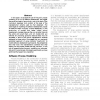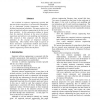1654 search results - page 34 / 331 » Comparing Two Software Design Process Theories |
IWSSD
1993
IEEE
15 years 2 months ago
1993
IEEE
In this paper, we propose the use of fine-grain process modelling as an aid to software development. We suggest the use of two levels of granularity, one at the level of the indiv...
100
click to vote
ICSE
2008
IEEE-ACM
15 years 10 months ago
2008
IEEE-ACM
According to Parnas's information hiding principle and Baldwin and Clark's design rule theory, the key step to decomposing a system into modules is to determine the desi...
APSEC
2002
IEEE
15 years 2 months ago
2002
IEEE
Our activities in software engineering typically fall into one of three categories, (1) to invent new phenomena, (2) to understand existing phenomena, and (3) to facilitate inspir...
VDA
2010
15 years 11 days ago
2010
Design patterns have proven to be a useful means to make the process of designing, developing, and reusing software systems more efficient. In the area of information visualizatio...
TASE
2007
IEEE
15 years 4 months ago
2007
IEEE
Design patterns capture expert design experience in generic design structure and behavior. A design pattern needs to be instantiated before using. It can be integrated with other ...


